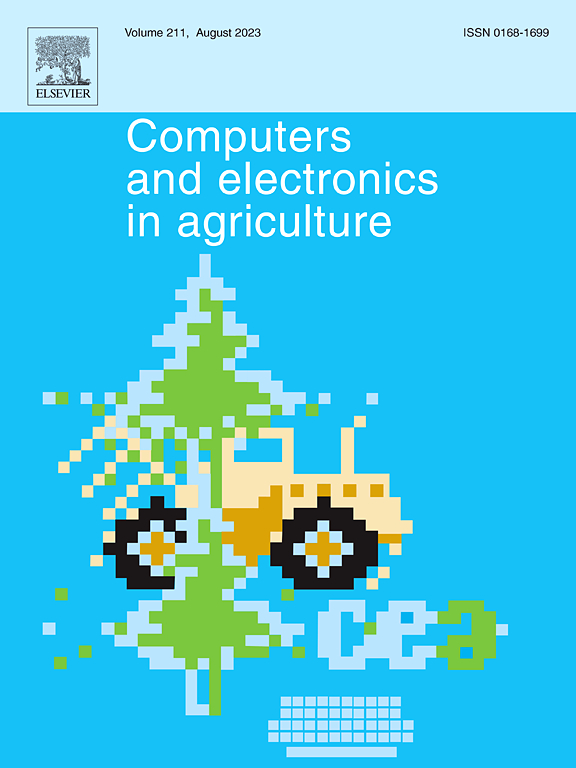无人机系统和机器学习驱动的数字孪生框架用于当季棉花生长预测
IF 7.7
1区 农林科学
Q1 AGRICULTURE, MULTIDISCIPLINARY
引用次数: 0
摘要
在过去的十年中,无人机系统(UAS)通过实现对作物生长和发展的远程监控,对包括精准农业在内的各个部门产生了重大影响。在整个生长季节有效地监测和管理作物对于优化作物产量至关重要。无人机系统监测数据和机器学习的整合极大地促进了作物生产管理,从而改善了灌溉调度、作物终止分析和产量预测等关键领域。本研究介绍了利用无人机捕获的RGB数据开发棉花作物的数字孪生(DT)。本DT的主要目的是预测棉花生长季节的各种作物特征,包括冠层覆盖度(CC)、冠层高度(CH)、冠层体积(CV)和超额绿度(EXG)。作为DT开发的一部分,预测分析使用机器学习回归从2020年至2023年收集的UAS数据中提取作物特征生长模式。在当前季节,实时UAS数据和历史增长模式结合起来,使用一种新的混合模型生成策略来预测增长模式。基于dt的预测与实际数据的比较表明,CC、CH、CV和EXG的RMSE较低。研究发现,提出的DT框架可以准确预测从播种后80天开始的未来30天的棉花作物特征,优于现有的预测方法。值得注意的是,CC、CH、CV和EXG的RRMSE分别为9%、13%、14%和18%。此外,还强调了预测数据在生物量估算和产量预测中的潜在应用,并强调了它们在优化农业实践中的重要意义。本文章由计算机程序翻译,如有差异,请以英文原文为准。
Unmanned aerial system and machine learning driven Digital-Twin framework for in-season cotton growth forecasting
In the past decade, Unmanned Aerial Systems (UAS) have made a significant impact on various sectors, including precision agriculture, by enabling remote monitoring of crop growth and development. Monitoring and managing crops effectively throughout the growing season are crucial for optimizing crop yield. The integration of UAS-monitored data and machine learning has greatly advanced crop production management, resulting in improvements in key areas such as irrigation scheduling, crop termination analysis, and predicting yield. This study presents the development of a Digital Twin (DT) for cotton crops using UAS captured RGB data. The primary objective of this DT is to forecast various cotton crop features during the growing season, including Canopy Cover (CC), Canopy Height (CH), Canopy Volume (CV), and Excess Greenness (EXG). Predictive analytics as part of DT development employs machine learning regression to extract crop feature growth patterns from UAS data collected from 2020 to 2023. During the current season, real-time UAS data and historical growth patterns are combined to generate growth patterns using a novel hybrid model generation strategy for forecasting. Comparisons of the DT-based forecasts to actual data demonstrated low RMSE for CC, CH, CV, and EXG. The proposed DT framework, which accurately forecasts cotton crop features up to 30 days into the future starting 80 days after sowing, was found to outperform existing forecasting methods. Notably, the RRMSE for CC, CH, CV, and EXG was measured to be 9, 13, 14, and 18 percent, respectively. Furthermore, the potential applications of forecasted data in biomass estimation and yield prediction are highlighted, emphasizing their significance in optimizing agricultural practices.
求助全文
通过发布文献求助,成功后即可免费获取论文全文。
去求助
来源期刊

Computers and Electronics in Agriculture
工程技术-计算机:跨学科应用
CiteScore
15.30
自引率
14.50%
发文量
800
审稿时长
62 days
期刊介绍:
Computers and Electronics in Agriculture provides international coverage of advancements in computer hardware, software, electronic instrumentation, and control systems applied to agricultural challenges. Encompassing agronomy, horticulture, forestry, aquaculture, and animal farming, the journal publishes original papers, reviews, and applications notes. It explores the use of computers and electronics in plant or animal agricultural production, covering topics like agricultural soils, water, pests, controlled environments, and waste. The scope extends to on-farm post-harvest operations and relevant technologies, including artificial intelligence, sensors, machine vision, robotics, networking, and simulation modeling. Its companion journal, Smart Agricultural Technology, continues the focus on smart applications in production agriculture.
 求助内容:
求助内容: 应助结果提醒方式:
应助结果提醒方式:


